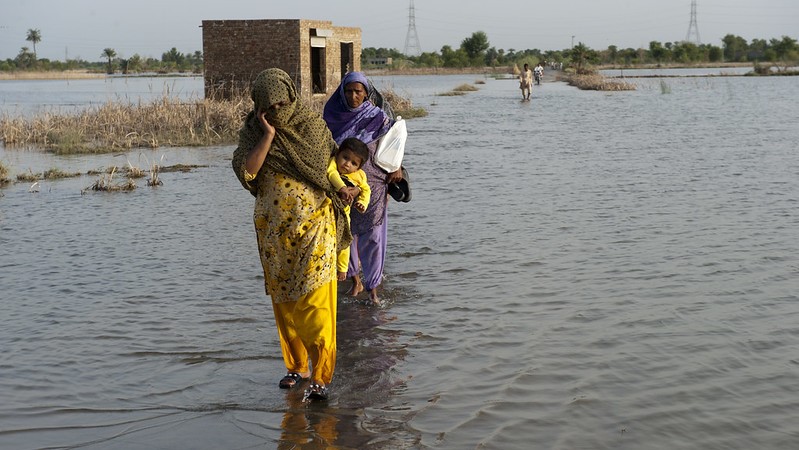For the first time, a major scientific body has identified the number people who live in contexts that are highly vulnerable to climate change: 3.3 to 3.6 billion people – nearly half the world’s population.
The figure in the latest Intergovernmental Panel on Climate Change (IPCC) report on climate impacts and adaptation paints a stark picture of the threat facing humanity. It also ventures into sensitive territory.
A map showing how scientists arrived at that number was deemed too misleading and problematic by many national representatives to include in the summary for policymakers. A version of it remains in the underlying report.
It painted much of the African continent red, for “very high” vulnerability, while Caribbean islands threatened by intense hurricanes and sea level rise – but with more money and infrastructure to cope – were depicted as less vulnerable. Australia, where 20 people died recently in extreme flooding, is ranked as one of the safest places to live.
This depiction matters both as a matter of pride – no country wants to be seen as a basket case – and access to resources. Under the UN climate convention, wealthy countries have agreed to provide financing to developing countries, “especially those that are particularly vulnerable”. But there is no agreed method for measuring vulnerability.
While IPCC reports do not prescribe policy, they may influence decisions on which countries merit special treatment.

A map on observed human vulnerability from the draft summary for policymakers of the IPCC sixth assessment report Working Group II, which did not make it into the final version. A similar map was published in the full report
The classification provides “a simplified bird view” of global vulnerability, said Jörn Birkmann, a coordinating lead author of the report, who researches climate vulnerability at the University of Stuttgart in Germany.
It helps show that Micronesia is more vulnerable than Australia, “even though there is a lot of flooding and suffering in Australia. And that’s an important message,” he told Climate Home.
Defining vulnerability is “a political question,” said Richard Klein, a senior researcher at the Stockholm Environment Institute. “There is no [single] truth when it comes to vulnerability because there are many different possible interpretations. Indices can tell you whatever you want them to tell you.”
The IPCC defines vulnerability in its report as “the propensity or predisposition to be adversely affected” and “lack of capacity to cope and adapt”.
The 3.3-3.6 billion figure corresponds to the estimated number of people that live in countries ranked in the two most vulnerable tiers of a five-tier classification system.
Mozambique, Somalia, Nigeria, Afghanistan and Haiti are labelled “very high” vulnerability, while India, Pakistan and the Philippines are in the “high” bracket.
On the flipside, 1.8-2 billion people are estimated to live in countries with low or very low vulnerability. The last category includes the UK, Australia, Canada and Sweden.
“We are not assigning a specific vulnerability label to a specific person. We are not saying that all people in Chad or Afghanistan are vulnerable,” explained Birkmann.
Rather, the authors looked at each country’s resilience as a whole, judged more by development criteria than climatic conditions.
China plans huge wind and solar power rollout in Gobi desert
The classification is based on indicators from the INFORM Risk Index and the World Risk Index, which cover factors such as access to basic infrastructure and health care, nutrition, extreme poverty levels, literacy rates, inequality, governance and perception of corruption.
It does not take into account exposure to sea level rise, storms, heat stress or floods. Nor does it include projected risks. That reflects a lack of consensus on how to compare the severity of various climate hazards.
Some countries expressed concerns the national averaging couldn’t account for differences within countries. Others considered criteria on governance and corruption as policy prescriptive and biased towards wealthy nations.
Debra Roberts, who co-chaired the IPCC’s work on climate impacts and adaptation, defended the approach. As head of the sustainable and resilient city initiatives unit at eThekwini municipality, the local government body for Durban, in South Africa, she understands the policy implications.
The vulnerability assessment was useful “in that it gives us a sense of the scale of the problem,” she told Climate Home. And while the map relies on a small set of indices, it talks to “a much broader narrative that some of our foundations are simply at risk”.
The IPCC acknowledges the limits of this national level assessment of vulnerability, noting that there are highly vulnerable groups in low vulnerability countries.
For example, in Northern America, urban ethnic minorities, immigrants and indigenous peoples are more likely to live in climate danger zones. Poor households and elderly people in Europe are more vulnerable to flooding and heat stress.
While important, these vulnerable demographics do not make a fundamental difference to the global picture, Birkmann said.
Countries like the US, Germany and the UK have the funding and institutional capacity to reduce these groups’ vulnerability, he added. “That’s not the case in Somalia.”
For Klein, having resources and capacity to respond to climate disaster doesn’t necessarily mean a government will put them to best use.
“I think it would be helpful to be much more differentiated about what it is that actually makes people vulnerable, not countries. And to help design adaptation strategies that lift people out of vulnerability. And that’s a different story,” he said.
